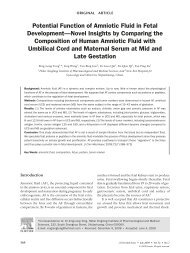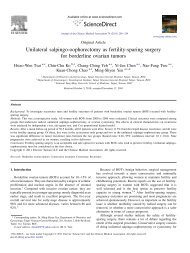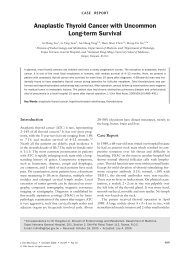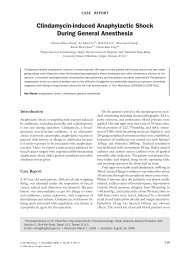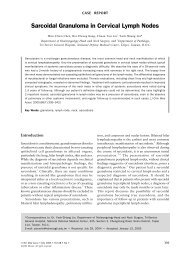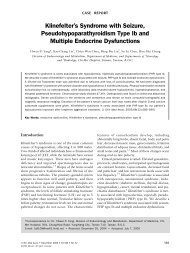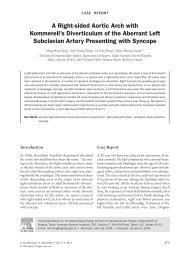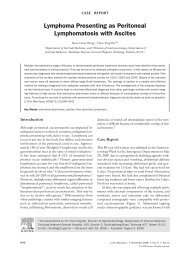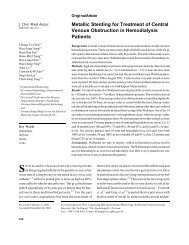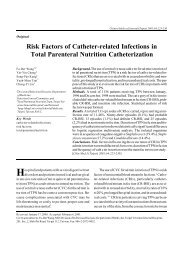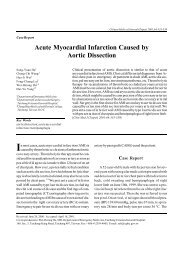Surgical Anatomy of Supratentorial Midline Lesions
Surgical Anatomy of Supratentorial Midline Lesions
Surgical Anatomy of Supratentorial Midline Lesions
You also want an ePaper? Increase the reach of your titles
YUMPU automatically turns print PDFs into web optimized ePapers that Google loves.
The anatomic course <strong>of</strong> the pericallosal artery shows some variations. In 60% <strong>of</strong> the hemispheres in our study, the A3 through A5 segments<br />
all coursed in the callosal sulcus; in a further 32.5%, at least one segment coursed in the cingulate sulcus. In the remaining 7.5%, the A3 through<br />
A5 segments all coursed in the cingulate sulcus and were never involved with the corpus callosum. Therefore, when performing an<br />
interhemispheric approach, one must take into consideration that the pericallosal artery may be located in the cingulate sulcus rather than the<br />
callosal sulcus. For this reason, care should be taken to ensure that the ipsilateral cingulate gyrus is not confused with the white corpus callosum.<br />
Perlmutter and Rhoton (24) were the first to classify the branches <strong>of</strong> the pericallosal artery that supply the corpus callosum as the“short<br />
callosal artery" and the “long callosal artery." They noted (24) that the short callosal arteries, which were found in 98% <strong>of</strong> the hemispheres,<br />
averaged seven per hemisphere and penetrated directly into the corpus callosum, rendering them the major arterial supply. In our study, four<br />
types <strong>of</strong> pericallosal artery branches to the corpus callosum were identified: the callosal, the cingulocallosal, the long callosal, and the recurrent<br />
cingulocallosal arteries. The short callosal arteries described by Perlmutter and Rhoton are anatomically consistent with the arteries that we<br />
describe here as“callosal" and “cingulocallosal." We prefer this differentiating nomenclature, because we agree with Malobabic et al.(17)<br />
and Wolfram-Gabel et al. (31) that the cingulocallosal artery does not penetrate the corpus callosum directly but instead provides the main<br />
supply to the pericallosal pial plexus within the callosal sulcus, which is the leading source <strong>of</strong> blood supply to the corpus callosum, and also<br />
contributes to the cingulate gyrus. The cingulocallosal artery was present in all <strong>of</strong> the hemispheres we studied.<br />
The callosal artery, on the other hand, directly supplied the superficial surface <strong>of</strong> the corpus callosum along the midline, without giving rise<br />
to any branches leading to the depths <strong>of</strong> the callosal sulcus. Those thin callosal arteries were present in 50% <strong>of</strong> the hemispheres.<br />
The long callosal artery, which arose from and ran parallel to the pericallosal artery in the callosal sulcus, was found in 55% <strong>of</strong> the<br />
hemispheres in our study. Perlmutter and Rhoton (24) found this artery in only a few cases in their study. The branches <strong>of</strong> the long callosal<br />
artery contributed to the formation <strong>of</strong> the pericallosal pial plexus. Thus, it participated in providing blood supply to the corpus callosum, the<br />
radiation <strong>of</strong> the corpus callosum, and the cingulate gyrus. In addition, it was usually a good source for the anastomosis with the posterior<br />
pericallosal artery.<br />
The recurrent cingulocallosal artery was a thin branch that arose from the major cortical branches <strong>of</strong> the pericallosal artery and contributed<br />
to the pericallosal pial plexus. It was present in 45% <strong>of</strong> the hemispheres we studied.<br />
Contribution <strong>of</strong> the posterior pericallosal artery<br />
Several studies have reported that the posterior pericallosal artery contributes to the blood supply <strong>of</strong> the corpus callosum and anastomoses<br />
with the pericallosal artery at the splenium (10, 12, 17, 18, 22, 28, 32-36). Yamamoto and Kageyama (32) found the posterior pericallosal artery<br />
to be present in 62.8% <strong>of</strong> the hemispheres studied, and Margolis et al. (18) reported it in 35% <strong>of</strong> the hemispheres in their study. Milisavljevic et<br />
al.(22) found anastomosis between the pericallosal artery and the posterior pericallosal artery in the splenial region in 75.7% <strong>of</strong> the hemispheres.<br />
The anastomosis <strong>of</strong> posterior pericallosal artery with the pericallosal artery at the splenium was present in all <strong>of</strong> the specimens (100%) we<br />
studied, which is consistent with the findings reported by Zeal and Rhoton (36).<br />
Our observations revealed three different anatomic patterns <strong>of</strong> the posterior pericallosal artery. In 80% <strong>of</strong> the hemispheres, the artery arose<br />
from either the PCA or one <strong>of</strong> its main branches, a few millimeters inferior to the splenium, and followed an S-shaped course toward the<br />
splenium; we called this pattern the “proximal type." In 10% <strong>of</strong> the hemispheres, the posterior pericallosal artery generally arose from the<br />
precuneal branch <strong>of</strong> the parieto-occipital artery and was located posterior to the splenium; we termed this the “distal type." In the remaining<br />
10% <strong>of</strong> the hemispheres, the posterior pericallosal artery distribution arose from both posterior and inferior locations; hence, we identified this as<br />
the “double type." In all instances, the artery coursed toward the splenium, where it divided into two main branches, superior and inferior.<br />
The superior branch formed the main trunk, ran within the callosal sulcus with a characteristic corkscrew-like tortuousity, and anastomosed with<br />
the posterior extension <strong>of</strong> the A5 segment, the long callosal artery, the median callosal artery, or two or three <strong>of</strong> these arteries. Therefore, they<br />
formed the dense portion <strong>of</strong> the pericallosal pial plexus. The inferior branch coursed beneath the splenium and then continued anteriorly to<br />
supply the fasciolar gyrus, the fornix, the tela choroidea <strong>of</strong> the third ventricle, the tail <strong>of</strong> the hippocampus, the pulvinar <strong>of</strong> the thalamus, or any<br />
combination <strong>of</strong> these.<br />
A very fine artery arising from one <strong>of</strong> the branches <strong>of</strong> the PCA and contributing to the blood supply <strong>of</strong> the splenium was a further finding<br />
resulting from our study. It was present in 25% <strong>of</strong> the hemispheres and was named the “accessory posterior pericallosal artery."<br />
It is worthy <strong>of</strong> mention that all <strong>of</strong> the variations in the main arterial systems <strong>of</strong> the corpus callosum can be investigated preoperatively using<br />
modern neuroradiological studies, including magnetic resonance imaging, magnetic resonance angiography, and cerebral angiography. Applying<br />
the knowledge <strong>of</strong> the anatomy <strong>of</strong> these variations to the neuroradiological studies allows the individual vascular patterns and collateral



